Opinion
Kenny Schachter Sees the Art Market Shimmy Along in a City Shaken by Protest
For better or worse, the art market is oblivious to the surrounding chaos.
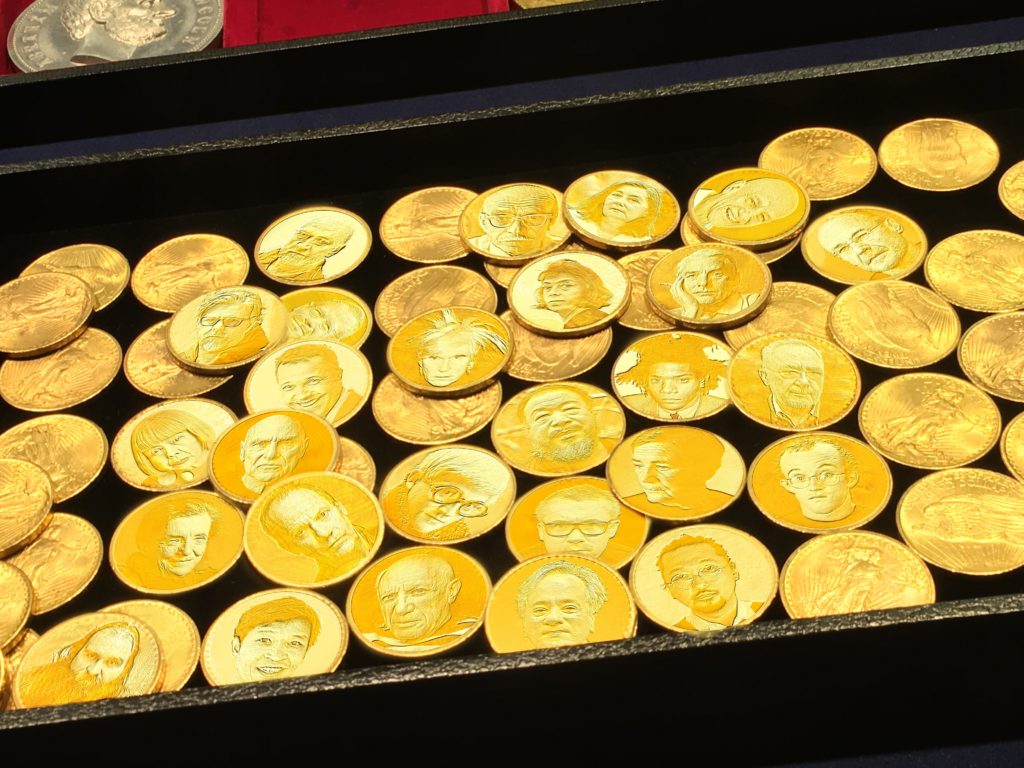
For better or worse, the art market is oblivious to the surrounding chaos.

Kenny Schachter

THE ART MARKET PLAYS ITS TRUMP CARD
New York is a city enveloped in an otherworldly atmosphere lined by an endless horizon of police cordons and seemingly spontaneous, raucous, pop-up protests that resemble school trips due to the youth of the demonstrators. There is a ten-block ring around Trump Tower in midtown which is ground zero for the new, new world order (or lack, we shall see). With police presence at levels not seen since the aftermath of 9/11, uncertainty is thick in the air. What a perfect storm for the most significant test of the art market in recent memory, if ever: New York’s November 2016 Impressionist, Modern and Contemporary auctions. And art won.
Further European disruption is also on the agenda, which could foresee a breakup of the Eurozone in the next few years spearheaded by populist movements simmering across the region in Holland, Austria, and maybe even France. Italy has called for a referendum as to whether they should keep the Euro as a currency. Global disruption and upheaval in political, social and economic arenas has sparked unforeseen red alert levels of alarm.
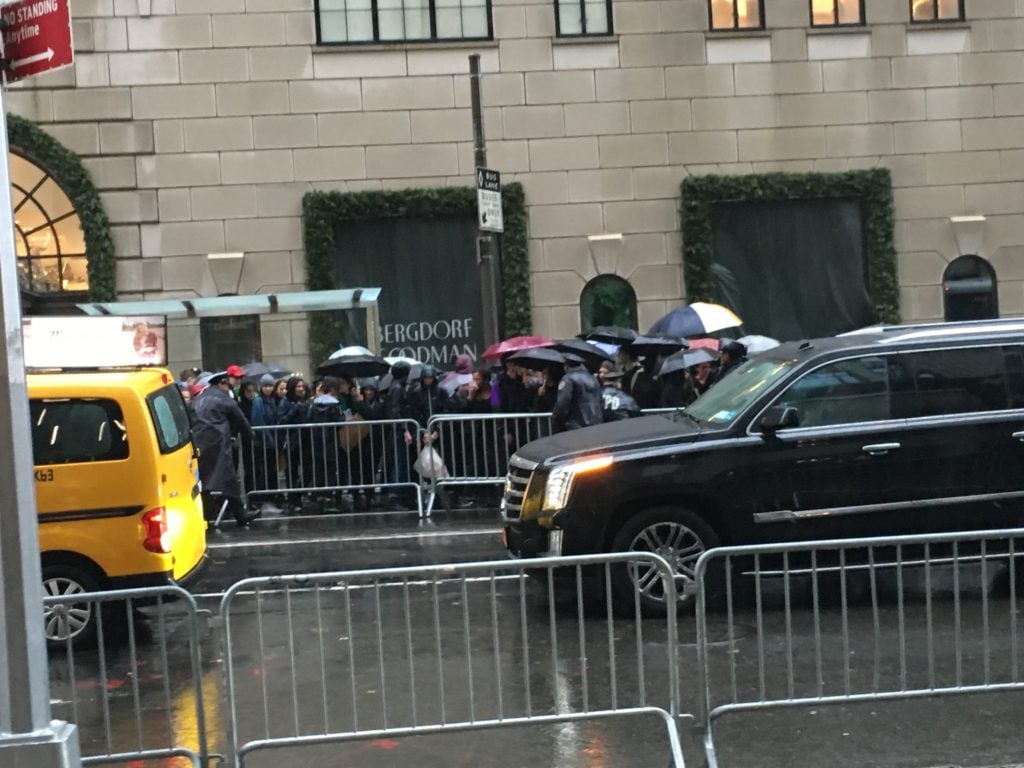
Protests in front of Trump Tower. Courtesy of Kenny Schachter.
But the art market chugs along oblivious to the surrounding chaos. From the headline grabbing big ticket items like Monet, de Kooning, Munch and Richter—with his very public disdain for the market, he must have been apoplectic with so many works on offer—there was also a trickle down to the day sale material and lesser market proven artists. A collective sense of dread was deflected. Most surprisingly of all, Phillips posted great numbers and drew deserved accolades for having successfully upped their game after trying (and fumbling) for so long; hiring away a chunk of Christie’s and Sotheby’s prized personnel paid off (they sent me a list of 15 recent defections).
Some of the contributing factors to the overall expansion of the breadth of the art market have to do with greater transparency afforded by technology—whereas art used to trade by photographic reproductions and auctions were largely for the trade—now you can watch sales live on your phone and images fly across the net like airborne contagion. However, in this tech defined era that has transformed the nature of how art is bought and sold, there is a paranoiac backlash underfoot. One dealer tried to sell me a Mark Bradford but only on the condition we meet in a restaurant to see the image on her laptop. She then refused to pass the image along to me (in any form). That was the end of that.
During the elections, there were cries that fake images of the Pope glad-handing (and endorsing) Trump, which were widely circulated on Facebook and other media outlets, figured in the outcome—call it the age of the post truth. There has long been an allergy to honesty on the transactional side of the art market, but last week I witnessed new heights of antipathy. A collector asked me to sell his Mark Grotjahn so he could do a Section 1031 exchange (a like/kind exchange per the Internal Revenue Code) to defer capital gains tax on the work purchased for a (relative) pittance in 2010. With prices for Grotjahn soaring (beyond reason?), he said he wanted to roll the money into something more established, like a De Kooning.
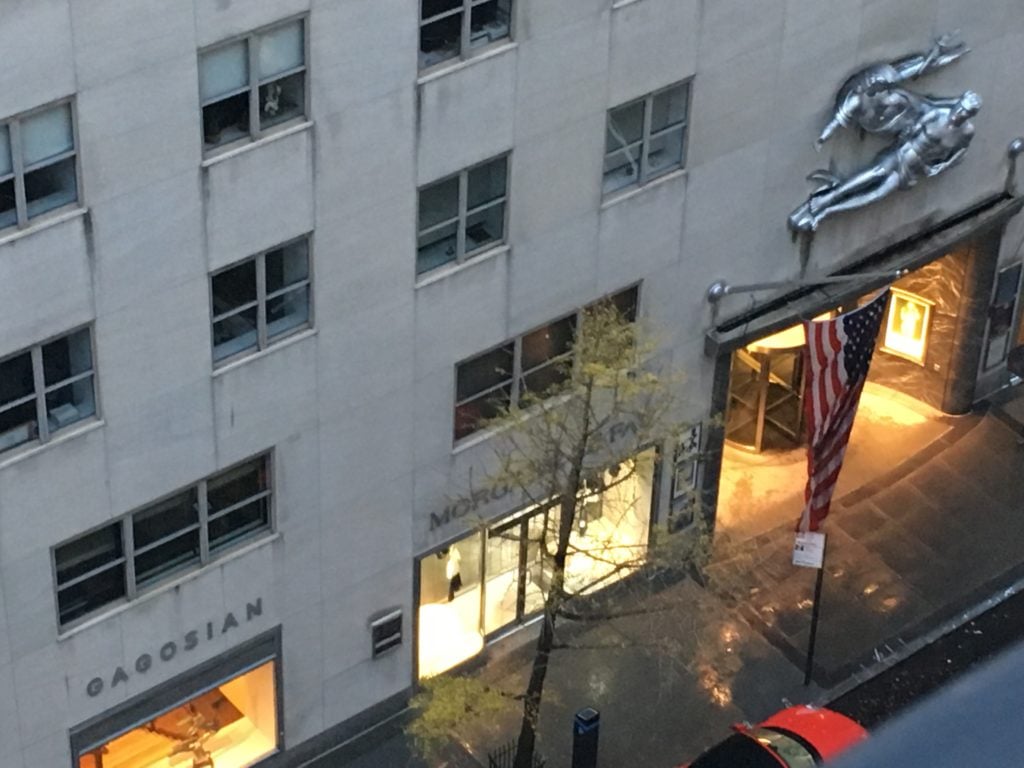
View of Gagosian Gallery from Schachter’s room at the Carlyle Hotel. Courtesy of Kenny Schachter.
On the subject of 1031 and capital gains, I’d wager that many art players preferred The Donald for the appeal of his favorable tax stance; it’s not the deplorables rejoicing in Trump’s victory so much as high bracket art collectors, though they’d never admit it.
What transpired with the Grotjahn beggared belief: I valued the 40 x 50 inch painting at between $5-6 million and showed it to a friend whose client made an offer. While the owner hemmed and hawed telling me he hadn’t found anything suitable to trade the work for, I spotted it hanging in the private treaty salesroom at Christie’s! When I confronted him on the matter, sending an image of what I had seen, he flatly stated it wasn’t his painting and sent a clumsily photoshopped mashup of the piece I had seen in his apartment and already had a jpeg he previously emailed of the actual work. In fact, he was using me to gauge the market—a common practice nowadays—and then turned around and sold it (to the Mugrabis, rumor has it), who had it immediately on reoffer for a whopping $9.5 million.
I initially checked into the venerable Carlyle Hotel which was crawling with dealers good, bad and in between; if you stayed the entire week (besides going broke) you’d lose days waiting for the elevator. When it did finally arrive, there was Patti Wong chairman of Sotheby’s Asia who I had only seen days before at a dinner in Shanghai. If you don’t incessantly chase the art market, you lose.
Bumping into Richard Nagy in the hotel fortuitously resuscitated a dormant Egon Schiele deal we’d previously discussed, while I heard of another private dealer who’s been known to loiter in the lobby in the hopes of doing the same (trying to sell art). Besides the snail-like elevator service—there are more than one, but they rarely function—my room came with a perfectly framed view of Gagosian. Two days later, I switched hotels.
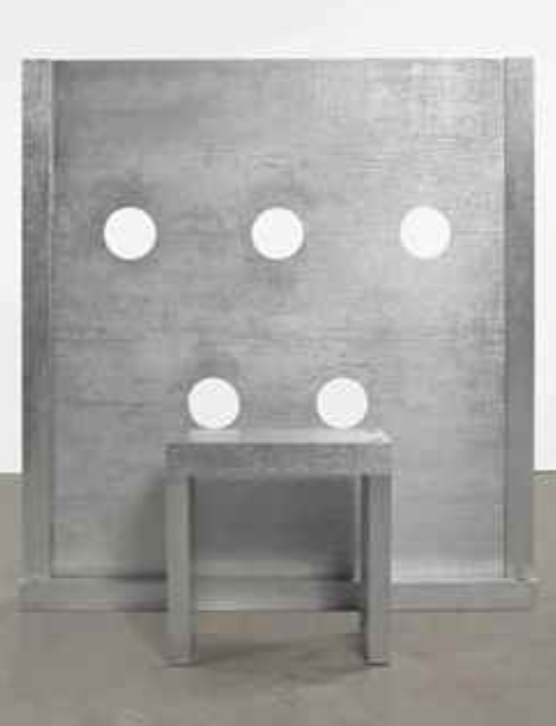
Cady Noland, Beltway Terror. Courtesy of Kenny Schachter
CHRISTIE’S AND SOTHEBY’S, TIED AT LAST
After years of Christie’s hammering Sotheby’s (sorry for pun), the two auction houses were neck and neck with near identical results for their contemporary evening sales. Phillips was the only house to make strong year-over-year advances despite the lack of particularly stellar material on offer across the board; and though not exactly nipping at the heels of the big two, the auction house is making itself felt. The market will always have blinders on, like a horse drawing a carriage in Central Park, and only sees (and values) a restricted picture of the overall art landscape. The numbers have been widely reported, but I will flesh out a couple of tidbits.
While there was endless coverage of the 18 Gerhard Richters offered for sale last week, which performed just about faultlessly, I found more fascinating (as recorded by the artnet Price Database) that between now and December 5, there are an additional 56 pieces coming to the sales block internationally.
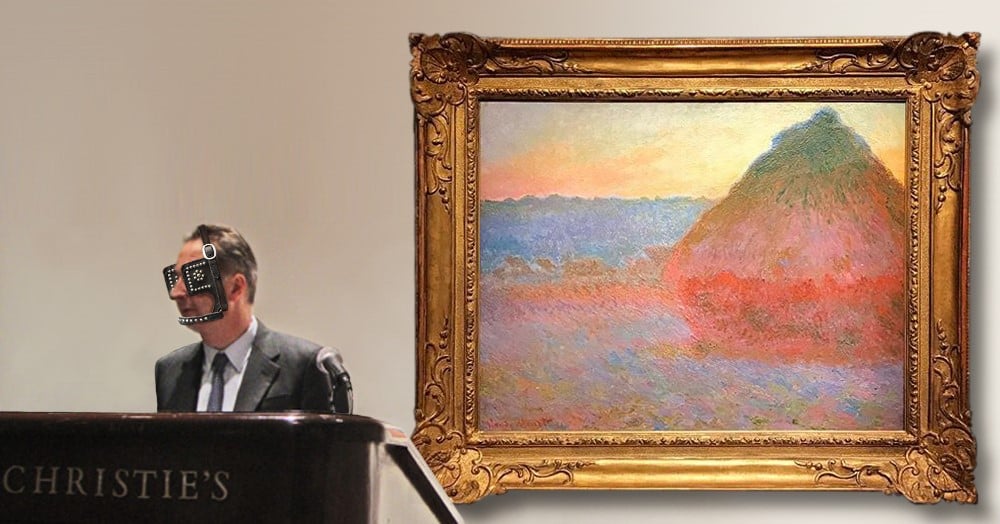
Collage by Kenny Schachter. Courtesy of Kenny Schachter.
Eric Clapton acquired three Richters in 2001 for $3,400,000 and sold two for a total of $55,200,000 in 2012 and 2013. The sale of the last of the group at Chrisite’s for $22,000,000 pushed the tally above $79,000,000. He may as well retire his guitars, many of which he’s already auctioned anyway along with endless guns and watches. He’s a savvy seller, practically in the league of the Nahmad family now for dealing prowess.
There’s the curious case of Cady Noland and her art. There was a work on offer from Christie’s evening sale entitled Beltway Terror (1993-94) consisting of a stock and pillory with an estimate of $800,000 – $1,200,000 (her record stands at nearly $10 million). The prickly artist is notorious for contesting works if she is unhappy with the context of their exhibition and/or resale, often resorting to the courts to defend her position no matter how erroneous. The following disclaimer, affixed directly to the wall beside her sculpture, was what in all probability caused its withdrawal prior to the sale:
Statement from the artist:
In an atmosphere of rapidly trading artwork, it is not possible for Cady Noland to agree or dispute the various claims behind works attributed to her. Her silence about published assertions regarding the provenance of any work or the publication of a photograph of a work does not signify agreement about claims that are being made. Ms. Noland has not been asked for nor has she given the rights to any photographs of her works or verified their accuracy or authenticity.
Though Noland’s words are not entirely clear, the import is that she has neither authenticated the work, nor given her blessing; or that Christie’s was too scared to ask. Perhaps Noland should be strapped into the pillory for unnecessarily interfering with the stream of commerce or at least to sideline her so the houses could get on with the business of selling her art.
From the Christie’s day sale, a recently bought Harold Ancart (Belgian, b. 1980) from 2014 with an estimate of $80,000-$120,000 (said to have been offered by Michael Ovitz) sold for a remarkable $750,500; his previous record was just shy of $100,000. Before the hammer fell, three Ancarts appeared on my phone for sale. Who said speculative flipping has flopped?
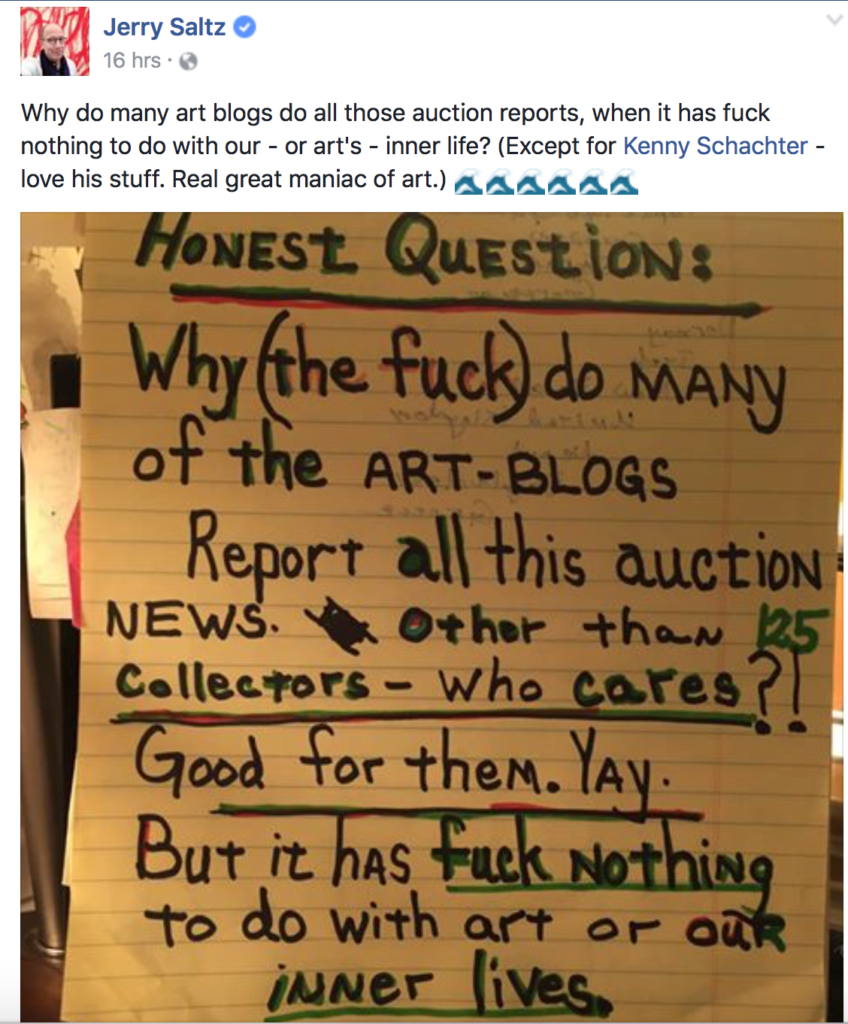
Jerry Saltz’s post on Instagram @jerrysaltz.
PHILLIPS GAINS GROUND WITH GUYTON, GROTJAHN, AND A ONCE-SLASHED LICHTENSTEIN
The Phillips evening sale was more like a matinee performance in that it was held at 5pm November 16 in order to avoid a scheduling clash with Christie’s Imp Mod sale later that evening. Josh Baer of the Baer Faxt sent a reminder prior to the onset for which he was probably paid (Phillips is a frequent advertiser in his newsletter) and to ensure some bidders showed up so he’d have something to write about. Alice Walton popped into the preview to check out their Clyfford Still, which sold for $13,690,000 on an estimate of $12,000,000 – $18,000,000. A specialist boasted Phillips is beginning to “eat into the value of Sotheby’s and Christie’s shareholders” (even though Christie’s is privately held—owned by Francois Pinault) and he might not be far off the mark in the coming years. But not yet.
The large nude canvas by Roy Lichtenstein, which had been previously vandalized while on exhibit in Austria with four 12-inch gashes, sold for $21,530,000 on an unpublished estimate of $20,000,000 – $30,000,000; the same Phillips expert boasted that Larry G. had a similar work on sale for $40,000,000 in his New York gallery. The repair was imperceptible on the face of the painting but said to look like Frankenstein from the back. Maybe they shouldn’t have had it restored as it would have been worth more as a Fontana—I just got offered a similarly-sized Fontana for $23,000,000.
Wade Guyton is the subject of two high profile exhibits in the city with mixed results. There is the exceptionally elegant show of the work of Andy Warhol, Christopher Wool, and Wade Guyton at Nahmad Contemporary and a one-person outing at Petzel’s uptown space. Of all the exhibitions on view in the city, the Petzel show could be the only deemed to be wading in political waters (soon that will change, and how), but only by default—the show presents hackneyed screen shots of the front page of the New York Times, which are computer-printed onto primed canvases—offered at $425,000 each. Lazy art. Guyton’s big blue signature X canvas with an estimate of $1,200,000 to $1,500,000 went for $1,990,000, while his record stands at nearly $6,000,000 for a coveted work with printed flames and U’s. A friend, who is a veritable ballet dancer when it comes to finessing higher bids before dropping out time and again, was the underbidder. Though he regularly buys at auction, he knows how not to.
A 2016 Mark Grotjahn work-on-paper, which was estimated at $600,000 – $800,000, sold for $1,450,000. With the way things are going, soon the auction houses might market works not yet made.
Though I usually refrain at public sales, I actually bought a Sigmar Polke painted photograph from 1975 for $150,000 on an estimate of $35,000 – $45,000; the escalation is not as mad as it sounds as I have another from the series purchased at the same level as the winning bid.
A frequent refrain heard from successful buyers as they exit the salesroom is: “I was thrilled to get it at that price level and was prepared to go much higher.” And I was. Luckily I bumped into Leo Koenig before the sale who is active in the Polke market and suggested buying the work together. He was kind and gentlemanly enough to withdraw from bidding when I expressed the desire to own the work outright. And it only cost me a dinner.
Phillips’ first Hong Kong sale is next week, November 27. Like Christie’s staging an upcoming selling show also in Hong Kong, the newfound gravitas of the Asian market is clear.
WELCOME TO CLUB SOTHEBY’S
With blaring music and lighting effects prior to the kickoff of their evening sales, Sotheby’s resembles a cross between a nightclub and Virgin airport lounge. Up to moments before the sale I knew of a dealer on a No Bid list because he owed money on a previous purchase. Reminded me of a UK radio advert for Amigo loans, and the accompanying jingle: “It’s good to have an amigo. Get a guarantor that’s what friends are for. You must not be bankrupt and be able to pay back the loan.” We all start off with the best intentions… An aside, why do the high-pitched colors in auction catalogues generally look nothing like the art they are said to represent? Like a mag spread of a Kardashian.
Jean-Michel Basquiat’s Brother’s Sausage (1983) was estimated at $15,000,000 to $20,000,000 and sold for $18,650,000 to Jose Mugrabi, the guarantor of the work owned by Peter Brant. Mugrabi said he had long been admiring the painting over the course of years, probably sitting across from Peter over various dinners. Typical of the convoluted connectedness of many an art deal, the art world can resemble intertwined worms under a rock, albeit smartly dressed, successful ones.
Rudolf Stingel’s record is $4,757,000 achieved twice within as many days last year (at Christie’s and Phillips). A stunning gold impression of a carpet on canvas came up with an estimate of $2,000,000 to $3,000,000 and sold for a tad over $4 million (good job Tad Smith and Co.), and underbid by the same person as the blue Guyton. This was the only work by the artist at auction the entire week, despite repeated complaints I heard accusing him of overproducing at the behest of Gagosian—the artist has had about seven or eight shows in a tiny storefront on Park Avenue run by the gallery, including one now of paintings based on images from the bar at the Carlyle Hotel. Stingel is a great artist whose prices have likewise had a steady, healthy increase over the years and I doubt he’d do anything at anyone’s urging.
By god I just had the best idea: in this time of uncertainty, when we all need to join forces together, there should be a joint Sotheby’s, Christie’s (and especially) Phillips touring show of The Passed Masters—Past and Present Bought-Ins.
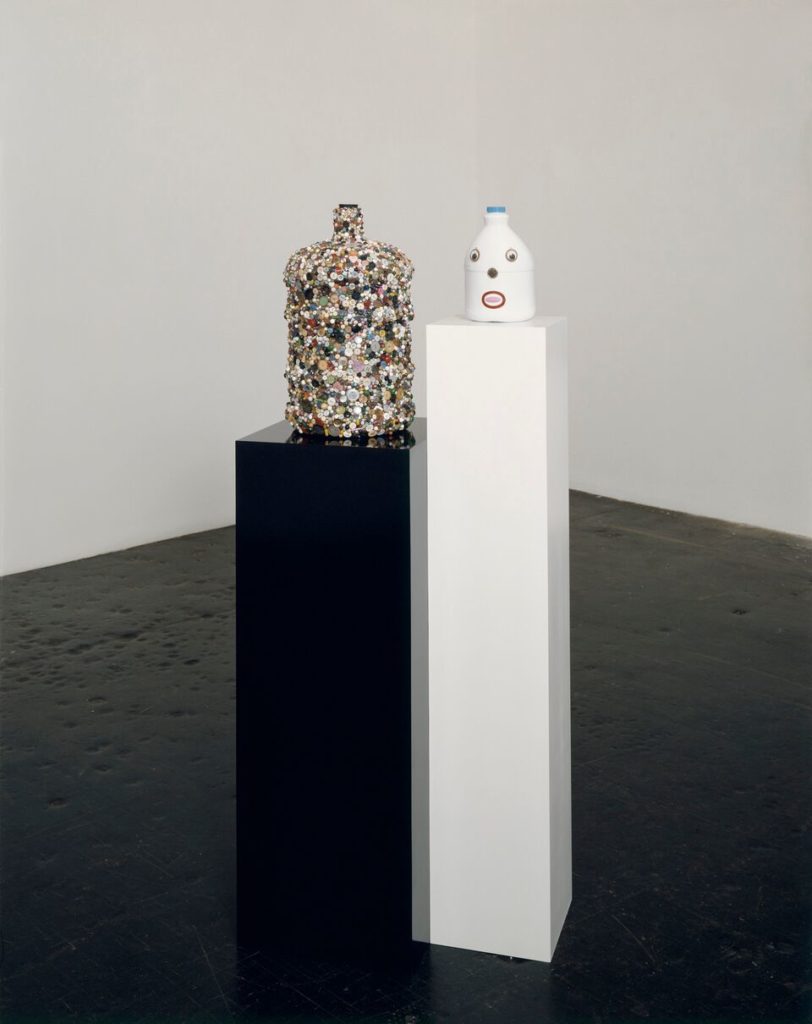
Mike Kelley Balanced by Mass and Personification (2001). Courtesy the Foundation and Hauser & Wirth Photo: Nic Tenwiggenhorn, Düsseldorf.
OF MEGA GALLERIES AND TRUMPIAN NEPOTISM
The Megas, galleries like Hauser, Zwirner, Pace, and Larry G. are like department stores with faceless worker bees with absolutely no connection to their audience or even what’s at hand. When I asked for a press release and checklist at Pace’s sublime Rothko exhibit (where I previously curated a Paul Thek show) the sitter asked me whether I wanted an art dealer. No, a hamburger.
Mike Kelley’s Memory Ware show at Hauser on 69th Street (one of three venues they operate in the city at present) was overwhelmingly extraordinary and must not be missed (t’s on through December 23). It’s an encyclopedia of Americana through kitsch accumulations of doodads from flea markets some of which are so dense you could spend a lifetime deciphering the images of a single piece. Though many are not for sale, a few are priced up to $4,500,000; Kelley’s recent auction record is $3,300,000 for a piece from the series (though privately they have sold for considerably more). No major works by the artist were up for sale this cycle and you certainly couldn’t have accused him of overproduction in his lifetime.
While standing in front of Aerodynamic Vertical to Horizontal Shift (1999), a mixed-media work in the exhibit that has an audio component, I momentarily mistook the sound for an impromptu street protest. Everyone is on edge in this town. The audio was actually comprised of planes taking off and the voices of air traffic controllers. I can only imagine what Kelley would have made of our present political predicament.

Another not-to-be-missed, once in a lifetime show was also at Hauser (at its 22nd Street location thru January 14), Phillip Guston’s “Laughter in the Dark, Drawings from 1971 & 1975,” which relates to another lunatic president, Richard Nixon. The series of drawings, done at lightning speed in only a few months’ time, are awe-inspiring in terms of their biting humor and phenomenal draftsmanship—do they even teach that anymore? I didn’t think so. I was jealous of his prodigious output. Wow. The few available pieces are priced from a few hundred thousand for works on paper to $4,500,000 for a medium-sized canvas.
There was a Picasso at Christie’s that he painted when he was all of 17 years old, estimated at $1,000,000 – $1,500,000 that sold for a staggering $3,007,500. In that vein, and in an act of Trumpian nepotism, another of the very best exhibits in town is that by two of my kids (located at 263 Bowery curated by Caio Twombly), aged 19 and 20 (what are they waiting for?) both at the School of Visual Arts.
Adrian is showing a series of small paintings that emanate from a website that randomly generates first lines for students with writer’s block (or indolence); they are little narrative vignettes as absurd as the website they were inspired by. Kai has canvases with circles of barely legible text over rich layered abstract grounds. One reads: “I lost my wallet I lost my phone I lost my mind.” I know how he feels. In addition, they basically relocated the entire contents of their apartment into the basement of the space and included art by me and my wife, Ilona Rich. I taught them well.

Jerry Saltz posted the following on his Facebook and Instagram accounts: “Why do many art blogs do all those auction reports, when it has fuck nothing to do with our—or art’s—inner life? (Except for KennySchachter love his stuff. Real great maniac of art.)”
Aside from being flattered, I wholeheartedly disagree: since it came off the cave wall it’s been bought and sold; art and money are like bees and honey. Albrecht Dürer (1471-1529), who’s auction record is just below $900,000 by the way, travelled with a satchel of monogrammed prints under his arm which he sold like hotcakes, with no meddlesome dealers angling for fat commissions. He also pursued his trademark in the courts on more than one occasion like a reverse Richard Prince, but equally money-wise.
Andrew Jackson threw an open house inauguration party (of parties) on March 4, 1829, which sparked a mob scene that almost destroyed the White House. The battle-tested president fled the scene as a huge crowd drank heavily, destroyed furniture, china and worse. Many of us are wondering, What is to come of the US under populist President Trump? The fear factor has made New Yorkers friendlier, which was an unintended silver lining to the week’s wildly strong auction results. But still, taking no chances, I just bought the following title: Life in the United Kingdom: A Guide for New Residents. Just in case, I’m hedging by studying Brit history with a view to citizenship.